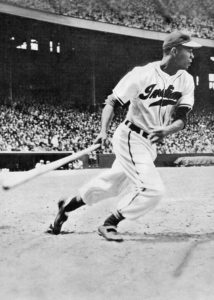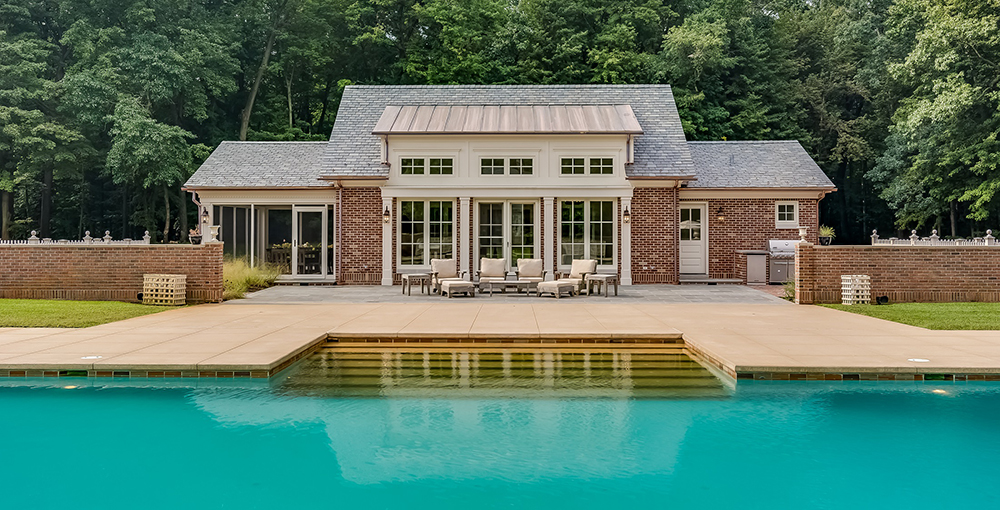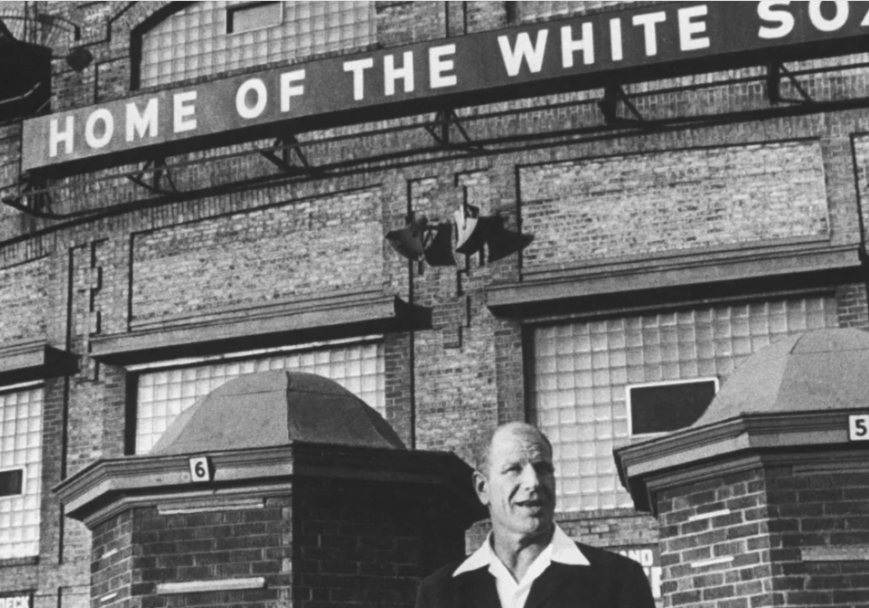
Big names in White Sox history, also lived in Hinsdale
By Larry Atseff
If you are a White Sox fan, 2021 is shaping up to be memorable. They were sensational in beating the Yankees in dramatic fashion in the inaugural Field of Dreams game played in Iowa on Aug. 9. They have led their division for most of the season by a large margin. And now that most of their key players have recovered from injuries, they can pace themselves so everyone is ready, just in time for the postseason. If you live in Hinsdale, you can be doubly proud. Two of the biggest names in White Sox history, Charley Comiskey and Bill Veeck, also lived in Hinsdale. This article will be Part 1, recounting the impact both men had on the team during much of its history, as well as baseball, in general. Part 2, in October, will focus on their time in Hinsdale. Let’s start at the very beginning.
“This is a game to be savored, not gulped. There’s time to discuss everything between pitches and between innings.”
Charles Comiskey, Founder of the White Sox
Charles Comiskey was born in 1859. He played first base and managed several teams between 1882 and 1894, including the St. Louis Stockings and Browns, the Chicago Pirates, St. Louis Browns and Cincinnati Reds. Comiskey is credited with the innovation of playing off of first base, instead of simply standing on the base, to strengthen infield defense. As a player, he compiled a .264 batting average, 29 home runs, 883 RBIs (runs batted in) and 419 stolen bases. As a manager, he earned an 839-542 record. At the turn of the century, Comiskey became the owner of a team he eventually called the Chicago White Sox. (He owned a team called the St. Paul Saints, which he moved to Chicago as the White Stockings. He later shortened the name to White Sox. See Sox logos, over time). Comiskey owned the team from 1900 to 1931, when he died at age 72. During his ownership, the White Sox won the World Series in 1906, and again in 1917. His team captured American League pennants in 1900, 1901, 1906, 1917 and 1919. He also oversaw building Comiskey Park in 1910. Unfortunately, during the end of his ownership, it is said, some of his players resented what they considered his “stinginess” (for example, he made them pay for laundering their uniforms). Eight players, including star outfielder “Shoeless” Joe Jackson, were accused of conspiring to throw the 1919 World Series. When the scandal broke late in the 1920 season, Comiskey suspended the players, knowing the decision would really hurt the team—and it did. The eight players were acquitted of wrongdoing in a trial, but Major League Baseball (MLB) commissioner Kenesaw Landis still issued a lifetime ban for all of them. Comiskey was posthumously inducted into the Baseball Hall of Fame in 1939. A lifesize bronze statue of Charles Comiskey is located on the center field concourse behind section 100.

Charles Comiskey II, (Charley, Chuck)
Upon Charles Comiskey’s death in 1931, ownership of the franchise devolved to son Lou Comiskey, who owned the Sox until 1939, when he passed away. It then passed to Lou’s wife, Grace Comiskey. Lou and Grace had three children: oldest sister Dorothy, middle child Gracie Lou, and Charley, born in 1925. At one point in the late 40’s and early 50’s, Dorothy helped her mother Grace run the club. In 1948, at 23, Charley joined the family business. He and John Rigney, Dorothy’s husband, worked to together to improve the ball club’s farm system. According to Billy Pierce, White Sox pitching ace from 1949-1961, (Charley) “helped do an awful lot developing the farm system with the White Sox. He made some of the big changes for the ball club from being a team that was quite down in the ‘30s and 40’s to becoming the ‘Go-Go White Sox’ of the 50’s, which led to the team winning the American League pennant in 1959.” Pierce added, Charley was well liked by the players throughout his tenure. “You’d never know he owned the ballclub. He was very friendly, very nice. He always mingled with the ball players.” With the death of mother Grace in 1957, there was a struggle for control of the club between Dorothy and Charley, who, by then, was cogeneral manager. Charley felt the club was his birthright and he sued for control. She owned 54% and Charley owned 46%. After a lengthy court battle, and a low bid from Charley, Dorothy sold her stake to Bill Veeck in 1958. In 1961, Veeck sold his stake to the Allyn family. In 1962, Charley Comiskey sold his stake as well to the Allyns, which ended Comiskey family ownership. While the Comiskeys and Veecks crossed paths when Dorothy sold her stake of the White Sox to the group headed by Veeck, the Comiskeys and Veecks met much earlier, when Bill’s father William Veeck Sr. served as president of the Chicago Cubs.
Bill Veeck, Sox Owner, and Baseball’s Legendary Entrepreneur and Innovator
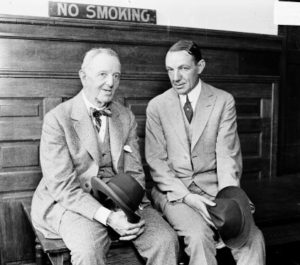
Charles Comiskey and William Veeck Sr.
Certainly, the Comiskeys loomed large in White Sox history. But then, Bill Veeck cane along and became known as one of the most imaginative entrepreneurs and innovators of the game, not only for the White Sox, but baseball in general. Veeck was just four years old when his father, a sportswriter, was named president of the Cubs. When he was growing up, Veeck learned about team management by working as a vendor, ticket salesman and junior groundskeeper. In fact, Cubs fans can thank Veeck for the ivy on the outfield walls, which he had planted in September 1937. Four years later, in 1941, Veeck partnered with former Cubs star Charlie Grimm to purchase the then AAA Milwaukee Brewers. Arriving in Milwaukee with just $11 in his pocket, Veeck nevertheless found ways to attract fans on a shoestring. He gave away live animals during games, scheduled morning games for night-shift workers, and even staged weddings at home plate. Efforts like these paid off. Five years and three American Association pennants later, Veeck sold the Brewers for a $275,000 profit. After a stint in The Marines in World War II, during which he lost Not all of his moves were entertaining in nature. In fact, in 1947, he made a bold move that was good for the entire game, signing Larry Doby as the first African-American player in American League history, just three months after the Brooklyn Dodgers of the National League signed Jackie Robinson as the first black man to play in the major leagues. Doby became the Indians’ starting center fielder a year later. Doby is quoted as saying, “One by one, [Indians manager] Lou [Boudreau] introduced me to each player. All the guys put their hand out—all but three. As soon as he could, Bill Veeck got rid of those three.” Veeck then made another move in the same vein. He signed 42-year-old Negro League legend Satchel Paige in 1948, making Paige the oldest rookie in MLB history. The Indians then proved they were back by capturing their first World Series in 28 years.
Baseball is almost the only orderly thing in a very unorderly world. If you get three strikes, even the best lawyer in the world can’t get you off.”
The fans responded as the team set an all-time record by drawing 2.6 million attendees that season. Never missing an opportunity to draw attention, when it was clear the 1949 Indians would not repeat as champions, Veeck literally buried the 1948 championship flag. An expensive divorce settlement forced him to sell his stake in the team. Looking for new opportunities, Veeck re-emerged two years later when he bought the struggling St.Louis Browns franchise. The Browns shared Sportsman’s Park with the more successful Cardinals. True to form, to make news, he hired former Cardinals stars Rogers Hornsby and Marty Marion as managers. He even decorated the shared Sportsman’s Park with Browns memorabilia. The Browns still struggled in 1951. Anxious to attract more fans, Veeck concocted arguably his most creative publicity stunt to that point. On Aug. 19, 1951, a 3-foot, 7-inch man named Eddie Gaedel walked to the plate as a pinch-hitter for the Browns in the bottom of the first inning in the second game of a doubleheader against the Tigers. Wearing the uniform number “1/8,” Gaedel used his minuscule strike zone to draw a walk on four pitches. He was promptly replaced for a pinch runner at first base, completing his day as the shortest man to ever play in the major leagues. American League president Will Harridge denounced the stunt as a mockery of the game, and voided Gaedel’s contract. Veeck responded by saying, “I try not to break the rules, but merely to test their elasticity.” (Insert picture of Gaedel at the plate) Five days after Gaedel’s appearance, Veeck was at it again. He introduced “grandstand manager’s night,” during which fans were given placards that told manager Zack Taylor whether the team should steal a base, bunt or change pitchers. As Taylor sat back in a rocking chair, Veeck and the fans led the Browns to a 5-3 win over the Philadelphia Athletics. Attendance doubled for the Browns, even though the team remained in the cellar in 1951 and 1952. Despite Veeck’s best efforts, the Browns’ financial issues, coupled with increasing pressure from opposing owners, forced him to sell the team to a group from Baltimore after the 1953 season.
Larry Doby was signed by Bill Veeck to the Cleveland Indians in 1947, the first black player in the american leagueAs noted earlier, Veeck was back in baseball in 1959 when he bought a controlling interest in the White Sox. Later that year, the Sox captured their first AL pennant in 40 seasons, and set a team attendance record with 1.4 million paying fans. True to form, Veeck immediately made his mark by installing baseball’s first “exploding scoreboard” at Comiskey Park, and adding players’ names to their uniforms. Poor health forced Veeck to sell the White Sox in 1961 to Arthur and John Allyn. After selling the White Sox, Veeck worked intermittently as a television commentator for ABC. Veeck moved to the Eastern Shore of Maryland with his family to convalesce. When his health improved, Veeck made an unsuccessful attempt to buy the Washington Senators, then operated the Suffolk Downs race track in Boston in 1969–70. In 1975, when a group was trying to buy and move the White Sox to Seattle, Veeck was the only potential buyer willing to keep the White Sox in Chicago. And, so, once more, Bill Veeck returned to the owner’s box at Comiskey in 1975. In his later years, Veeck stayed active and continued to attract attention. He conducted trades in a hotel lobby during the winter meetings, in full view of the public. In 1976, America’s bicentennial year, on opening day, Veeck celebrated a “Spirit of ’76” parade at the stadium. He marched in the parade as a peglegged fife player, bringing up the rear. More Veeck innovations. He encouraged announcer Harry Caray, to sing “Take Me Out to the Ballgame” to the Sox faithful.
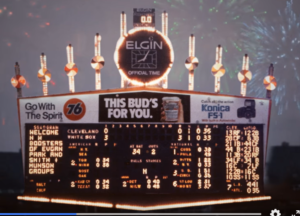
Bill Veeck’s exploding scoreboard installed in 1960 at Comiskey Park
He was the only owner who supported Curt Flood in Flood’s successful bid for free agency. Later, he came up with the idea of adapting to free agency with “Rent A Player”, making offers to stars of other teams in their option year. He reactivated Minnie Minoso for eight at bats in 1976 so Minnie could claim playing baseball over four decades. Not everything Bill did went smoothly. In 1979, Veeck ran an explosive promotion that literally backfired: he hosted “Disco Demolition Night,” an event that caused a riot at Comiskey, and forced the White Sox to forfeit the game to the Detroit Tigers. In 1980, Veeck concluded that his group lacked sufficient resources to stay in baseball. In 1981, he agreed to sell the Sox to Ohio shopping mall developer Edward DeBartolo. Three weeks after the season ended, American League owners rejected DeBartolo’s bid, reportedly concerned about his ownership of racetracks. Veeck then turned to a group led by Jerry Reinsdorf that he had rejected that summer and finally sold the team. Reinsdorf and his group have owned the team since, for more than 40 years. During that time, they won a World Series in 2005, and replaced old Comiskey Park with a new stadium, complete with naming rights. Today, the stadium is called Guaranteed Rate Field, and the team is in the hunt for another World Series in 2021. After he sold the Sox in 1981, Veeck would spend much of the next few years in the bleachers at Wrigley Field watching Cubs games. His son Michael, 69, is still active in baseball, currently President of the St. Paul Saints, a Triple-A team in Minnesota. Like his Dad, Mike has said I am a big believer in “Fun is Good”. Bill Veeck passed away on Jan. 2, 1986, and was elected to the Baseball Hall of Fame in 1991.
FOOTNOTES
We have drawn from several sources for this article. Included are
www.baseballhall.org/hall-of-famers/veeck-bill
Chicago Historical Society Encyclopedia Britannica Wikipedia:
Charles Finley, Chuck Finley, Michael Veeck
www.baseball-reference.com/bullpen/Bill_Veeck
The Hinsdale Historical Society also contributed copies of newspaper accounts over the years of the activities of Comiskeys and Veecks


